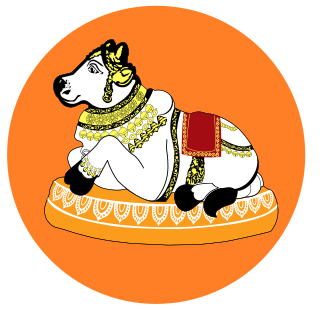 W
WThe Nayanars were a group of 63 saints living in Tamil Nadu during the 6th to 8th centuries CE who were devoted to the Hindu god Shiva. Along with the Alwars, their contemporaries who were devoted to Vishnu, they influenced the Bhakti movement in early medieval South India. The names of the Nayanars were first compiled by Sundarar. The list was expanded by Nambiyandar Nambi during his compilation of material by the poets for the Tirumurai collection, and would include Sundarar himself and Sundarar's parents.
 W
WAdipatthar or Adhipattha Nayanar is one of the 63 Nayanmars. He was a sincere devotee of Shiva and lived in the Chola kingdom at present day Nagapattinam by the sea shore.
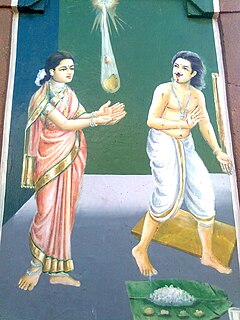 W
WKaraikal Ammaiyar, one of the three women amongst the 63 Nayanmars, is one of the greatest figures of early Tamil literature. She was born at Karaikal, South India, and probably lived during the 6th century AD. She was a devotee of Shiva.
 W
WAnaya Nayanar, also known as Anaya and Anayar, is a Nayanar saint, venerated in the Hindu Shaivite sect. Anaya is considered to be the 14th of the 63 Nayanars. His playing of the Panchakshara on his flute so pleased the supreme god, Shiva, that he took Anaya away to the eternal world.
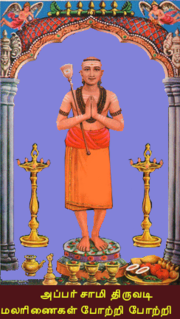 W
WAppar Tirunavukkarasar Nayanar, also known as Navukkarasar and Appar, was a seventh-century Śaiva Tamil poet-saint, one of the most prominent of the sixty-three Nayanars. He was an older contemporary of Thirugnana Sambandar. His birth-name was Marulneekkiyar. He was called "father" by Sambandar, hence the name Appar.
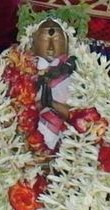 W
WApputhi Adigal, also spelt as Apputhi Adikal, Atputhi Adigal, Apputi Adigal, Appoodi Adikal, Appoothi Adikal and Appudhi Adigal and known as Appuddi Nayanar, was a Nayanar saint, venerated in the Hindu sect of Shaivism. He is generally counted as the twenty-fifth in the list of 63 Nayanars. He is described as a contemporary of Appar or Thirunavukkarasar, one of the most prominent Nayanars.
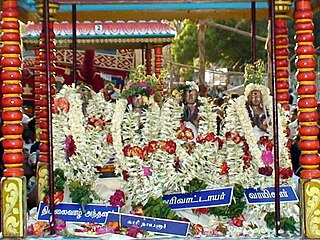 W
WArivattaya Nayanar or Thayanar was the 12th Nayanar, a group of 63 Shaivite saints, venerated as great devotees of the Hindu god Shiva. Nayanars lived before or during the lifetime of Sundaramurthy Nayanar.
Auguste Baillayre was a painter from France. He was a professor at Ecolle de Belle Arte of Chişinău and the first director of the National Museum of Fine Arts, Chişinău.
 W
WChandesha or Canda or Chandeshwara is one of the 63 Nayanmars. Processional bronze images of him generally show him as a boy, with entwined locks of hair, standing with his hands in Añjali Mudrā and with an axe in the crook of his arm. In the Shaiva temples of South India, his shrine is positioned within the first enclosure wall of the temple complex and to the North East of the lingam. He is there typically shown seated, with one leg dangling downwards, a hand on one thigh and an axe clasped in the other. He faces inwards towards the main temple wall. He is depicted as deeply lost in meditation, and devotees snap their fingers or clap their hands to attract his attention. Another explanation, since he is considered to be the guardian of the temple belongings, is that devotees clap their hands to show that they are leaving the temple empty-handed. It is also customary to leave even the sacred ash inside the temple itself.
 W
WCheraman Perumal Nayanar, one of the sixty-three Nayanars, was a bhakti poet-musician and religious teacher from medieval south India. Historians tentatively identify the Perumal with Rajasekhara, the 9th century ruler of the Chera Perumal kingdom of Kerala.
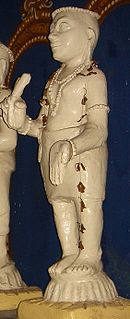 W
WEripatha Nayanar, also known as Eripathar, Eripatar, Eribattar, Eripattan', Eripaththa Nayanar and Eripattha Nayanar, is Nayanar saint, venerated in the Hindu sect of Shaivism. He is generally counted as the eighth in the list of 63 Nayanars.
 W
WIsaignaniyar, also spelt as Isainaniyar, Isaignaniyaar, Isaignaniar and Isaijnaniyar and also known as Isai-jnani Ammaiyar, is the mother of Sundarar, one of the most prominent Nayanar saints. She is herself regarded as a Nayanar saint, venerated in the Hindu sect of Shaivism, along with her husband Sadaiya Nayanar. She is generally counted as the last in the list of 63 Nayanars.
Iyarpagai Nayanar, also known as Iyarpagaiar, Iyarpahai Nayanar, Iyarpagaiya Nayanar and Iyarppakai Nayanar is a Nayanar saint, venerated in the Hindu sect of Shaivism. He is generally counted as the third in the list of 63 Nayanars.
Kalarsinga Nayanar, also known as Kalarsinga, Kazharsinga, Kalarcinkan, Kalarsingan, Kalarsinganar, Kalarsingar, Kalarcingar and Kalar-chingar (Kalar-singar), was a Nayanar saint, venerated in the Hindu sect of Shaivism. He is generally counted as the fifty-fifth in the list of 63 Nayanars. While his identity remains a matter of debate, many scholars identity Kalarsinga Nayanar as the Pallava king Narasimhavarman II (Rajasimha), who reigned between 700 and 728 CE.
 W
WKannappar was a staunch devotee of Shiva and is closely associated with Srikalahasteeswara Temple. He was a hunter and is believed to had plucked his eyes to offer to Srikalahasteeswara linga, the presiding deity of Srikalahasti Temple. He is also considered one of the 63 Nayanars or holy Saivite saints, the staunch devotees of Shiva. According to historical chronicles, he was Arjuna of the Pandavas in his past life.
 W
WKari Nayanar is the 47th Nayanar saint. Traditional hagiographies like Periya Puranam and Thiruthondar Thogai detail his legendary life and services to the Hindu god Shiva. Kari Nayanar was a vedic Brahmin devotee as well as a Tamil poet with an understanding of Sanskrit. The poet-saint compiled the vedic truths in Kovai(Anthology), a Tamil composition titled Karikkovai. Therefore the saint got the name as Kari Nayanar.
Kotpuli, also known as Kotpuliyar and Kotpuli Nayanar, was a Nayanar saint, venerated in the Hindu sect of Shaivism. He is generally counted as the fifty-seventh in the list of 63 Nayanars.
Kutruva Nayanar, also known as Kootruva , Kutruva, Kutruvar, Kootruvar, Kurruva Nayanar, Kurruvar, Kurruvan, Kutruvanar, Kurrrruvar, Kalappallan and Kalappalar, was a chieftain of Kalandai and a Nayanar saint, venerated in the Hindu sect of Shaivism. He is generally counted as the 39th in the list of 63 Nayanars. Kutruva is often described as a Jain, who became a devotee of Shiva, the patron god of Shaivism.
 W
WManakanchara Nayanar, also known as Manakkanychaara Nayanar, Manakkancharar, Manakanjara Nayanar, Mankkanjara Nayanar and Manakkanjarar, was a Nayanar saint, venerated in the Hindu sect of Shaivism. He is generally counted as the twelfth in the list of 63 Nayanars. Like other Nayanars, he was a fervent devotee of the god Shiva. Manakanchara Nayanar is dated to the 8th century and was a contemporary of Eyarkon Kalikkama Nayanar, a Nayanar saint and his son-in-law as well as Sundarar. He is described to have cut his daughter's hair and given it to Shiva disguised as a Shaiva ascetic, on her wedding day.
Munaiyaduvar, also known as Manai Aduvar Nayanar, Munaiyaduvar Nayanar, Munayaduvar, Munayaduvaar, Munaiyaduvaar and Munaiyatuvar, was a Nayanar saint, venerated in the Hindu sect of Shaivism. He is generally counted as the 52nd in the list of 63 Nayanars. Munaiyaduvar is described as a mercenary soldier, who would fight for the weak and vanished and use the fees received in service of his patron deity Shiva and the god's devotees.
Murkha Nayanar, also known as Moorka Nayanar, Murka Nayanar, Moorkha Nayanar, Murgga Nayanar, Moorkka Nayanar and Murkhar, is a Nayanar saint, venerated in the Hindu sect of Shaivism. He is generally counted as the thirty-second in the list of 63 Nayanars.
Murthi Nayanar, also spelt as Murthy Nayanar, Moorthy Nayanar and Murti Nayanar and also known as Murtti, is a Nayanar saint, venerated in the Hindu sect of Shaivism. He is generally counted as the fifteenth in the list of 63 Nayanars.
 W
WNami Nandi Adigal, also spelt as Naminandi adigal, Naminandi adikal and Naminanti Atikal, and also known as Naminandi and Naminandhi, is a Nayanar saint, venerated in the Hindu sect of Shaivism. He is generally counted as the 27th in the list of 63 Nayanars.
 W
WNandanar, also known as Tirunalaippovar (Thirunaallaippovaar) and Tiru Nalai Povar Nayanar, was a Nayanar saint, who is venerated in the Hindu sect of Shaivism. He is the only Dalit saint in the Nayanars. He is generally counted as the eighteenth in the list of 63 Nayanars. Like the other Nayanars, he was a devout devotee of the god Shiva.
 W
WNarasinga Muniyaraiyar Nayanar is the 40th Nayanar saint. Traditional hagiographies like Periya Puranam and Thiruthondar Thogai detail his legendary life and services to the Hindu god Shiva.Narasinga Muniyaraiyar Nayanar was the chieftain of the state Tiru Munaipadi.Muniyaraiyar The saint was a contemporary of Sundarar.
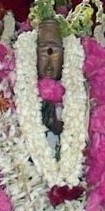 W
WPugal Chola, also known as Pukal Chola, Pukazhchozha Nayanar, Pugazh, Pukazhcchozhar, Pukal Cholan and Pugal Chola Nayanar, is described as a Chola ruler and was a Nayanar saint, venerated in the Hindu sect of Shaivism. He is generally counted as the eighth in the list of 63 Nayanars.
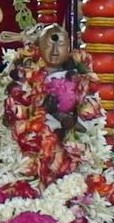 W
WPugazh Thunai Nayanar, also known as Pugazhthunai Nayanar, Pugalthunai Nayanar, Pukazhtthunai Nayanar, Pukazhtthunaiyar and Pukalttunai, was a Nayanar saint, venerated in the Hindu sect of Shaivism. He is generally counted as the fifty-sixth in the list of 63 Nayanars.
 W
WPusalar is an eighth-century Nayanar saint, venerated in the Hindu sect of Shaivism. He is generally counted as the fifth-eighth in the list of 63 Nayanars. His hagiography speaks how he created a grand temple for Shiva in his mind and how his patron god Shiva preferred attending the consecration of his mind temple, instead of a grand temple created by a Pallava king.
 W
WRajasekhara, identified with Rama Rajasekhara, was a Chera Perumal ruler of medieval Kerala, south India. Rajasekhara is usually identified by historians with Cheraman Perumal Nayanar, the venerated Shaiva (Nayanar) poet-musician. Two temple records, from Kurumattur, Areacode and Thiruvatruvay, Vazhappally, mention king Rajasekhara.
 W
WSadaiya Nayanar - 7th century, also known as Sadaya Nayanar, Sadaiyan (Cataiyan), Sadaiyanar (Cataiyanar) is the father of Sundarar, one of the most prominent Nayanar saints. He is himself regarded as a Nayanar saint, venerated in the Hindu sect of Shaivism, along with his wife Isaignaniyar. He is generally counted as the sixty-second in the list of 63 Nayanars, Isaignaniyar being the last Nayanar. Sundarar is the only Nayanar with both his parents enlisted as Nayanars. The inclusion of Sadaiya Nayanar, streams solely on the basis on his association with Sundarar, rather than individual merit.
 W
WSakkiya Nayanar was a Nayanar saint, venerated in the Shaiva sect of Hinduism. He is generally counted as the thirty-fourth in the list of 63 Nayanars. He was a crypto-Hindu posing as a Buddhist, practicing Shaivam in secrecy. He was reported to have worshipped Lord Shiva, his patron god, by hurling stones at his iconography.
 W
WSambandar or Thirugnana Sambandar was a young Saiva poet-saint of Tamil Nadu who lived around the 7th century CE.
Seruthunai Nayanar, also known as Seruthunai, Seruthunaiyar and Seruttunai Nayanar, was a Nayanar saint, venerated in the Hindu sect of Shaivism. He is generally counted as the 55th in the list of 63 Nayanars.
Sirappuli Nayanar, also known as Sirappuli, Sirapuli Nayanar, Sirappuliyar (Chirappuliyar), was a Nayanar saint, venerated in the Hindu sect of Shaivism. He is generally counted as the thirty-fifth in the list of 63 Nayanars. Sirappuli Nayanar is described to have served the devotees of the god Shiva and worshipped the god with various ritual practices.
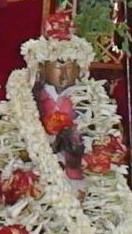 W
WSomasi Mara Nayanar, also known as Somasi Maranar, Somasi Marar, Somasimarar and Somasira Nayanar, is a Nayanar saint, venerated in the Hindu sect of Shaivism. He is generally counted as the thirty-third in the list of 63 Nayanars. He is also called Marar, Maran and Mara Nayanar, names he shares with Ilayankudi Mara Nayanar. The two Nayanars are generally differentiated by the prefixes "Somasi" and "Ilayankudi". He was a contemporary and devotee of Sundarar.
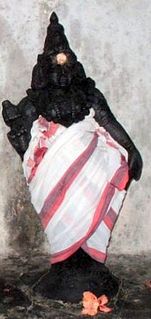 W
WSundarar, also known affectionately as Tampiran Tōḻan was an eighth-century poet who was one of the most prominent Nayanars, the Shaiva bhakti (devotional) poets of Tamil Nadu. He was a contemporary of Cheraman Perumal and Kotpuli Nayanar who also figure in the 63 Nayanmars. The songs of praise are called Thiruthondathogai and is the original nucleus around which the Periyapuranam is based. The Periya Puranam, which collects the legends of the Nayanars, starts and ends with him. The hymns of seventh volume of the Tirumurai, the twelve-volume compendium of the poetry of Tamil Shaiva Siddhanta, were composed by him. His songs are considered the most musical in Tirumurai in Tamil language.
Tiru Nilakanta Yazhpanar was a Nayanar saint, venerated in the Hindu sect of Shaivism. He is generally counted as the sixty-first in the list of 63 Nayanars. While the first part of his name can be spelt as Tirunilakanta, Tirunilakantha, Tiru Neelakanta, Tiru Nilakanta, Nilakantan and Thiruneelakanda, Yazhpanar is spelt as variously as Yalppanar, Yalapannar, Yalpanar and Yazhpaanar. He is described as a companion of Sambandar, one of the most prominent Nayanars.
 W
WTirumular was a Tamil Shaivite mystic and writer, considered one of the sixty-three Nayanmars and one of the 18 Siddhars. His main work, the Tirumantiram, which consists of over 3000 verses, forms a part of the key text of the Tamil Shaiva Siddhanta, the Tirumurai.
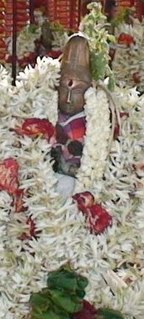 W
WTiruneelanakka Nayanar, also known Tiruneelanakka, Nilanakkar and Nilanakkan, was a Nayanar saint, venerated in the Hindu sect of Shaivism. He is generally counted as the twenty-eighth in the list of 63 Nayanars. He is described as a contemporary of Sambandar, one of the most prominent Nayanars.
Tirunilakanta Nayanar, also known as Tirunilakanta, Nilakantan and Tirunilakantar (Thiruneelakandar) was a Nayanar saint, venerated in the Hindu sect of Shaivism. He is generally counted as the second in the list of 63 Nayanars.
 W
WVayilar, also known as Vayilan, Vayila Nayanar, Vayilar Nayanar and Vayilar of Mayilai, was a Nayanar saint, venerated in the Hindu sect of Shaivism. He is generally counted as the fifty-first in the list of 63 Nayanars. He is said to worshipped the god Shiva, his patron, by his Mind and built a grand temple for him in his mind.